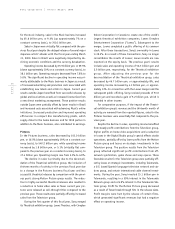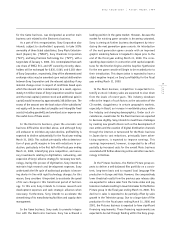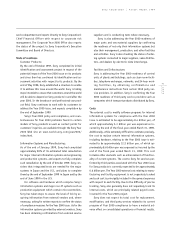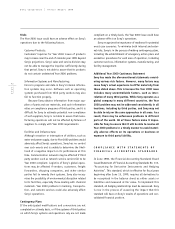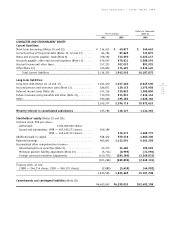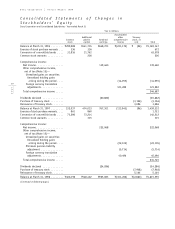Sony 1999 Annual Report Download - page 42
Download and view the complete annual report
Please find page 42 of the 1999 Sony annual report below. You can navigate through the pages in the report by either clicking on the pages listed below, or by using the keyword search tool below to find specific information within the annual report.
Sony Corporation Annual Report 1999
40
page
In October 1998, the Accounting Standards Executive
Committee (“AcSEC”) of the American Institute of Certified
Public Accountants issued an exposure draft of a proposed
Statement of Position, “Accounting by Producers and
Distributors of Films” (“Exposure Draft”) which, if adopted
as issued, would significantly change the current account-
ing for the motion picture and television business. The
Exposure Draft proposes, among many changes, that theat-
rical advertising expense be amortized over a significantly
shorter period, that advertising expenses for other markets
be expensed as incurred and that revenue from television
syndication contracts be recognized over the contract period
rather than upon initial availability of the product to the
licensee. The transition from Sony’s current accounting prac-
tices to those required by the Exposure Draft would result in
a cumulative charge to Sony’s results of operations in the
period of adoption, although there would be no cash flow
impact. Comments on the Exposure Draft are being reviewed
by AcSEC and the Financial Accounting Standards Board.
Depending on the nature, scope, and merits of the comment
letters, the Exposure Draft may be modified in part or in its
entirety. Accordingly, the impact to Sony is not currently
known, as it may vary significantly depending on the final
Statement of Position as well as the exact date it becomes
effective. For illustrative purposes, if the Exposure Draft were
implemented as issued without change, as of March 31, 1999,
the cumulative non-cash charge would be approximately 950
million U.S. dollars. The date of issuance of the final State-
ment of Position has not yet been determined; however, as
currently drafted, the earliest required implementation date
for Sony would be April 1, 2000.
In the Insurance business, the life insurance business
in Japan faces increasing competition due to deregulation
and a continuation of the difficult environment for manag-
ing assets. However, Sony believes that its life insurance
business in Japan has been well-positioned in the market
through a strong sales force represented by approximately
4,200 Lifeplanners. Sony expects to incur start-up expenses
for its planned automobile insurance business in Japan,
which is scheduled to commence in October 1999.
In the Other business, operating losses are expected to
continue due to start-up expenses at such long-term strate-
gic businesses as satellite distribution services including
program supplying businesses in Japan, and location-based
entertainment complexes in San Francisco, Berlin, and Tokyo.
EURO
On January 1, 1999, the introduction of the Euro in eleven
countries created a single-currency market (the EMU) in much
of Western Europe. For a transitional period from January 1,
1999 through January 1, 2002, the former national curren-
cies of the EMU member states will also remain legal tender.
Most of Sony’s subsidiaries were fully prepared to handle
Euro transactions with third parties from January 1, 1999.
However, ongoing system implementation projects delayed
full Euro compliance in some countries. The temporary al-
ternative procedures that have been put in place to address
this situation have not generated and are not expected to
generate an increase in administrative costs in the future.
Very few customers have so far requested transactions in
Euro; therefore, at this time there has been no direct im-
pact on product pricing in Europe directly attributable to
the introduction of the Euro.
Regarding transactions within Sony, the majority of these
have been switched to the Euro from the former national
currencies of the EMU countries since April 1, 1999. In ad-
dition, the reporting of Sony subsidiaries in the EMU zone
and of European consolidated financial statements have been
made in Euro since April 1, 1999. The switch to the Euro has
resulted in a reduction in foreign exchange commissions
and hedging costs.
Several revisions to the information systems of Sony
subsidiaries in Europe were carried out in the fiscal year
ended March 31, 1999, in order to accommodate the differ-
ent types of Euro transactions and reporting. These revi-
sions have not generated a material adverse effect on
consolidated operations and financial results.
While additional investments to accounting information
systems for the Euro will be required in the subsidiaries
operating in EMU countries, the impact is not material.
THE YEAR 2000 ISSUE
Sony’s Year 2000 Project
Sony recognizes the importance of the Year 2000 issue in
relation to business continuity risks and customer service,
and has initiated a comprehensive corporate-wide project
to implement a smooth transition into the year 2000. The
project is coordinated and supervised by the Corporate Year
2000 Office, which is principally composed of corporate staff
from Sony’s information systems department and customer








